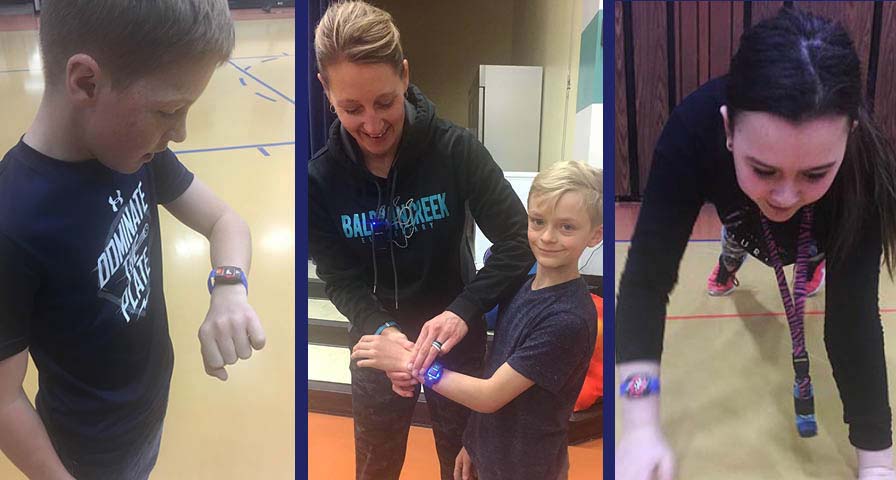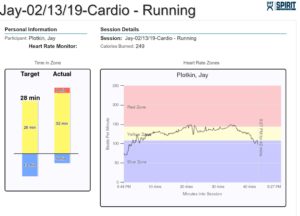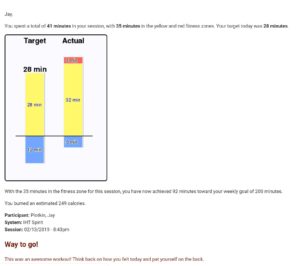Principal, Colleagues Take Note of Innovative Health Awareness Program After Fourth-Grade Students Improve PACER Results using IHT Heart Rate Monitors
Students in Misty Atnip’s PE classes at Baldwin Creek Elementary School (Lander, Wy.) saw their 20-meter shuttle test scores improve just weeks after they began wearing the IHT ZONE wrist heart rate monitor in class.
Atnip turned to IHT’s heart rate technology — the ZONE paired with the IHT Spirit System assessment software — in December to connect with a group of students struggling with their fitness.
“Really it’s kind of interesting with our fourth-grade boys,” she said. “Their fitness level is quite low. We’ve never had a group of boys be this low.”
 Atnip’s first 20-meter shuttle assessment of the year showed less-than-impressive results. By mid-January, only weeks after she introduced the IHT ZONEs to her students, things had changed. Students were working harder and staying in target heart rate zones longer.
Atnip’s first 20-meter shuttle assessment of the year showed less-than-impressive results. By mid-January, only weeks after she introduced the IHT ZONEs to her students, things had changed. Students were working harder and staying in target heart rate zones longer.
“There was already quite a bit of difference in January,” she said. “On the (20-meter shuttle) test, I’ve definitely seen some improvement.”
Students embraced the technology, though some appeared frustrated at first when what they saw on their ZONE monitors didn’t match the effort they thought they were giving.
“There are two students who are fairly fit,” Atnip explained. “They would come over to me worried that they felt they were working hard, could feel their heart rate and feel the effects of working hard, but their ZONE still had them in the blue (low intensity) zone. It’s led to some great conversations because I do have some really fit kids where I’ve had to adjust their resting heart rate.”
Students show genuine excitement – regardless of their fitness level – when they reach their daily goals.
“I’ve had quite a few kids who have said, you know, when they reach their goal, tell me ‘I feel really good inside.’ They’re relating that endorphin release with hitting their target heart rate.”
Along with the feeling of accomplishment, students are beginning to understand which activities help them get into their target heart rate zones. Burpees will never be a class favorite, but students understand the benefits.
“They’re starting to really figure out which activities in life get them right away into that vigorous (red) or even the moderate (yellow) zone,” Atnip said. “It’s funny how they say ‘I don’t like burpees, but it definitely gets my heart rate up quickly.’”
Students Use Heart Rate Data to Help Shape Lessons
Since they started their heart rate training wearing the ZONE monitors, students have asked for more fitness-based activities instead of games such as volleyball.
“They tell me that they don’t get to move that much when we work on volleyball,” Atnip said. “They have realized that jump rope or some kind of chase game keeps them moving and helps them stay in their target zones. They are giving me feedback on my lessons, and that’s a good thing.”
The technology has helped Atnip refine her curriculum. Students have PE just twice a week for 30-minute sessions, so she starts each class with a Tabata to get them moving immediately with an exercise circuit that includes:
- Planks
- Squat jumps
- Laps around the gym
Atnip knows she must make the most of every valuable minute. The results, both anecdotally and objectively based on the heart rate data and improved assessment scores, show she is.
“I just think that it’s now increased the whole class’ approach to physical activity, not just those kids who are competitive and athletic,” she said. “It’s taken the whole group up. I feel like I have differentiated my learning to reach them now because now they’re getting that immediate feedback.”
Early Heart Rate Training Results Getting Noticed Around School Community
The improved fitness – and improved attitudes that have come from students achieving their goals – have been visible both to the parents and to Atnip’s colleagues.
Parents, who in the past had little reason to communicate with the teacher, are thanking her for looping them in via the Spirit System emails which she can automatically send to parents when she chooses.
“I’ve gotten quite a few emails from parents just saying how much they appreciate getting that email,” she said. “It’s a great little thing (for parents) to get a little snapshot of their kid’s day while they are at work.”
Other teachers have also seen benefits from Atnip’s new PE routine. Since she started using the ZONEs in December, her colleagues have sought her out to provide their feedback as well. Academic readiness has increased in step with student fitness.
“I have teachers who come back to me later and they’ll say, ‘Oh my gosh, you know, they came back and they were just ready to roll. They weren’t just sluggish.’ Now other teachers are asking me if kids hit their goal. It’s become a community effort.”
Her efforts also caught the eye of Principal Jade Morton, who recognized Atnip as the school’s teacher of the year.
“This year’s selection is one that has completely transformed a program and has made her subject area one of innovation and an exemplar for the district,” Morton said. “Not only has Misty transformed PE into a highly rigorous and engaging class for our students, her integration of technology with the IHT heart rate monitor system and health awareness has been impressive to say the least. This approach has transcended into opportunities such as the Bobcat Trail and adds to the overall fitness and mindfulness of our students and staff.”
As the current school year begins to wind down, Atnip is already looking at how she can use the technology to build on this year’s success. With the students’ successes and feedback, she’s motivated to recreate her curriculum.
“I’m trying to just step out of the box so that kids get a new take on fitness and physical activity and get their heart rate up,” she said.




